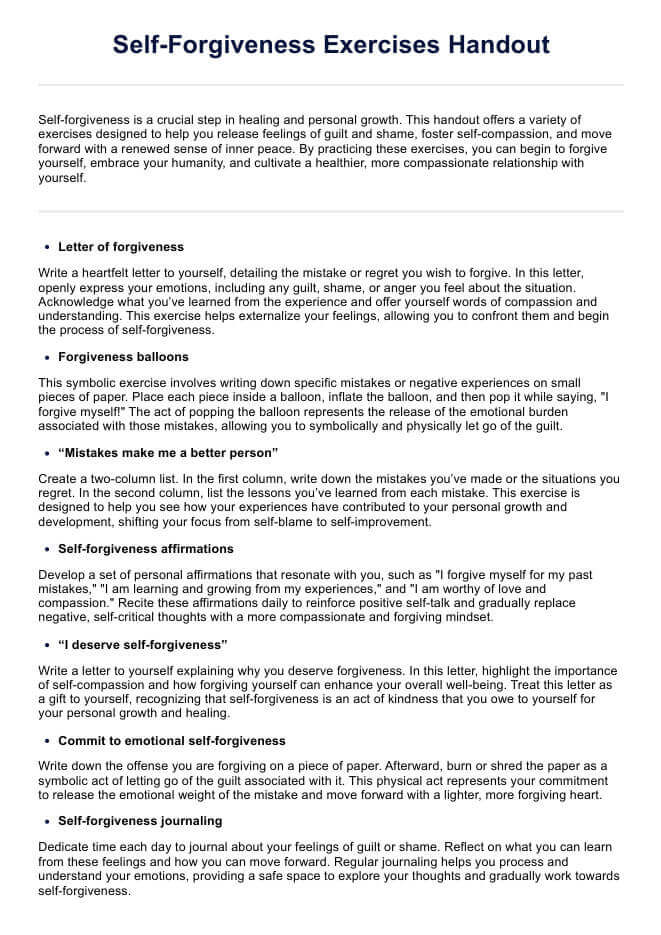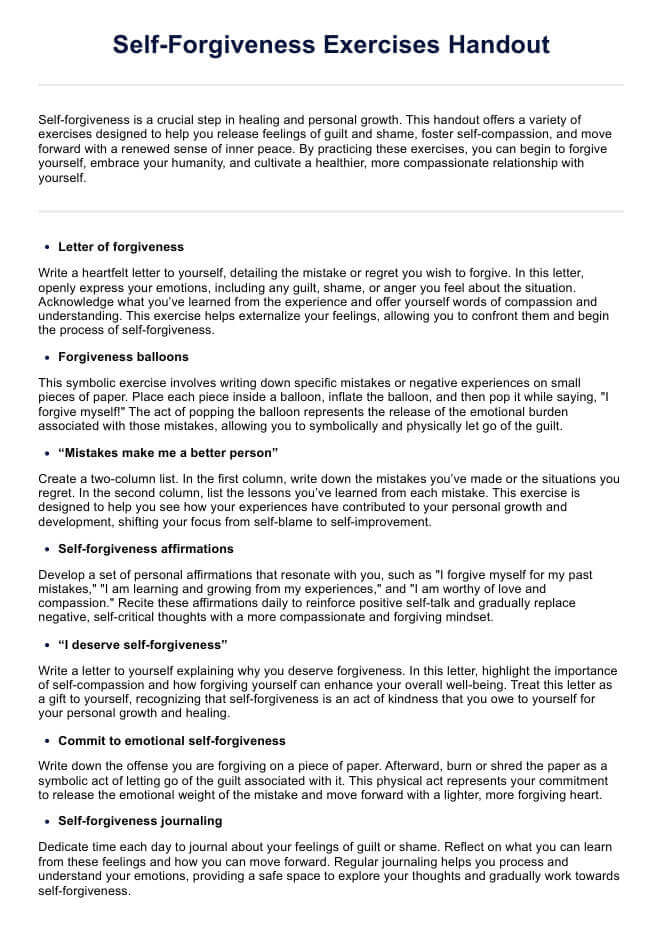Self-Forgiveness Exercises Handout
Explore self-forgiveness exercises to release guilt, build self-compassion, and enhance personal growth.


Importance of self-forgiveness
Self-forgiveness is a critical aspect of emotional healing and personal growth. It involves recognizing and accepting responsibility for past actions or mistakes while letting go of negative feelings, self-judgment, and guilt. Self-forgiveness allows individuals to release the burdens of shame and regret, which can hinder their ability to move forward.
Practicing self-forgiveness is essential for maintaining mental and emotional well-being. Holding onto guilt or self-blame can lead to a negative self-image, low self-esteem, and even mental health issues such as depression and anxiety. By forgiving oneself, individuals can break free from these destructive patterns and cultivate self-compassion.
Moreover, the self-forgiveness process is important for fostering resilience. It encourages individuals to learn from their mistakes rather than being defined by them, enabling them to grow and improve over time. This ability to forgive oneself enhances personal development and strengthens one's capacity to cope with future challenges and setbacks.
Self-forgiveness can also play a vital role in relationships. When individuals accept responsibility for their actions and forgive themselves, they are likelier to extend forgiveness and understanding to others. This, in turn, can lead to stronger, more supportive relationships.
Self-Forgiveness Exercises Handout Template
Self-Forgiveness Exercises Handout Sample
5 examples of self-forgiveness exercises
Self-forgiveness is a vital component of emotional healing and personal growth. Below are five effective self-forgiveness exercises that can help in this process:
1. Journaling
Writing in a journal allows individuals to express their thoughts and emotions freely, helping them process feelings of guilt or shame. Reflecting on their actions and identifying the lessons learned allows individuals to release negative emotions and move towards self-forgiveness. Journaling can also involve writing a letter to oneself, acknowledging past mistakes, and offering compassion and understanding.
2. Mindfulness meditation
Practicing mindfulness meditation helps individuals recognize their thoughts and feelings without judgment. This exercise encourages self-compassion by allowing individuals to observe their emotions related to guilt or regret without becoming overwhelmed by them. Over time, mindfulness can help reduce self-critical thoughts and promote a more forgiving and accepting attitude towards oneself.
3. Self-compassion exercises
Engaging in self-compassion exercises, such as self-compassionate statements or loving-kindness meditation, encourages individuals to treat themselves with the same kindness and understanding they would offer a friend. These exercises help replace self-criticism with empathy, making forgiving oneself for past mistakes easier.
4. Cognitive restructuring
This self-forgiveness exercise involves challenging and reframing negative thoughts that contribute to feelings of guilt or unworthiness. Identifying and disputing irrational beliefs about oneself helps develop a more balanced and realistic view of one's actions, which is crucial for self-forgiveness. Cognitive restructuring helps individuals understand that making mistakes is a part of being human and that they deserve forgiveness.
5. Role-playing
In a therapeutic setting, role-playing can be a powerful exercise for self-forgiveness. Individuals may be guided to play the role of someone they have wronged or even their own role from a compassionate perspective. This exercise helps them understand the situation from multiple angles, fostering empathy for themselves and allowing them to see their actions in a broader, more forgiving context.
How does our Self-Forgiveness Exercises Handout work?
Our Self-Forgiveness Exercises Handout is structured to guide individuals through their self-forgiveness journey in a clear and practical way. It begins with a brief introduction emphasizing the importance of releasing guilt and fostering self-compassion as part of personal growth.
Each exercise is presented concisely, making it easy to understand and follow. The exercises include reflective practices, such as journaling and letter writing, that encourage introspection and emotional expression.
It also introduces more symbolic and interactive exercises, such as forgiveness balloons and role-playing, which help to externalize and release negative emotions. This theme is reinforced in various exercises, such as creating self-forgiveness rituals and developing personal affirmations to build a more compassionate and forgiving mindset over time.
The handout emphasizes self-compassion and viewing mistakes as opportunities for growth. It uses various approaches, such as meditation and visualization. This variety allows individuals to choose the exercises that resonate most with them, ensuring a personalized approach to self-forgiveness.
How this handout may benefit mental health professionals
This handout on self-forgiveness exercises can be a valuable resource for mental health professionals in several ways:
- Therapeutic tool: It provides a range of practical exercises that therapists and counselors can incorporate into their sessions with clients who struggle with guilt, shame, or self-blame. These exercises can be used to guide clients toward self-forgiveness, helping them to process and release negative emotions in a structured way.
- Client education: Mental health professionals can use this handout to educate clients about the importance of self-forgiveness in their healing journey. By explaining the benefits of each exercise, professionals can encourage clients to practice self-forgiveness techniques outside of therapy, reinforcing the work done in sessions.
- Personalization of treatment plans: The handout offers a variety of exercises, allowing mental health professionals to tailor their approach to each client's individual needs. Depending on the client’s specific challenges, professionals can choose the most appropriate exercises to help clients develop self-compassion and forgiveness.
- Enhancing client engagement: This handout provides concrete, actionable steps to increase client engagement in the therapeutic process. Patients who are actively involved in their healing process are more likely to experience positive outcomes.
- Supporting long-term recovery: The exercises outlined in the handout promote long-term emotional resilience by teaching clients how to manage and forgive themselves for past mistakes. This can prevent future emotional distress and contribute to sustained mental health improvements.
Commonly asked questions
Self-forgiveness challenges often include deep-rooted guilt, shame, and a tendency to hold oneself to unrealistically high standards. These feelings can make it difficult for individuals to let go of self-blame and move forward.
Mental health professionals can help clients learn to forgive themselves by guiding them through processes of self-compassion, reframing negative thoughts, and helping them understand the importance of learning from mistakes rather than being defined by them.
It can be difficult for a person to forgive themselves when they have a strong sense of guilt, shame, or fear of judgment or when they struggle with perfectionism and hold themselves to impossible standards.





















-template.jpg)


















































































